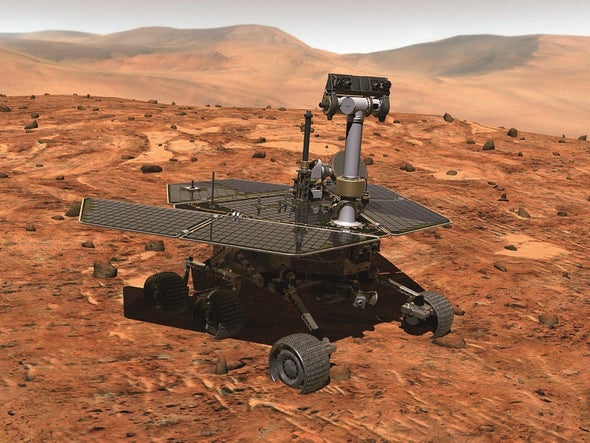(单词翻译:单击)
听力文本
This is Scientific American — 60-Second Science. I'm Steve Mirsky.
"You know, when this little rover landed, the objective was to have it be able to move 1,100 yards and survive for 90 days on Mars."
NASA Administrator Jim Bridenstine.
"And instead here we are 14 years later, after 28 miles of travel. And today we get to celebrate the end of this mission."
Bridenstine spoke at a press conference at NASA's Jet Propulsion Laboratory today, February 13, 2019. The media event was called to officially mark Opportunity's demise. The rover has been quiet since last June, when a severe dust storm covered its solar panels. Only about one fortieth of the typical amount of solar radiation was getting through to power the rover. And it's been silent since.

"Opportunity is very close to the equator, so there's lots of solar power."
Cornell University astronomer Steven Squyres talking to Scientific American back in March, 2006. He was the principal investigator for the science payload of the Mars Exploration Rover Project, better known as the two rovers Spirit and Opportunity. They landed on Mars three weeks apart in January 2004.
The Spirit rover, much further from the equator, stopped reporting back to NASA in 2010. But Opportunity, like an interplanetary Energizer Bunny, just kept going. Along the way it found ample evidence for the presence of water during Martian history.
Back in 2006 Squyres offered this confident and, we now know, correct assessment: "I think Opportunity could last for quite a long time."
For Scientific American — 60-Second Science. I'm Steve Mirsky.
参考译文
这里是科学美国人——60秒科学。我是史蒂夫·米尔斯基。
“当这个小型探测器登陆时,它的目标原本是能在火星上移动1100码并生存90天。”
美国国家航空航天局(简称NASA)局长吉姆·布里登斯廷说。
“而在14年后,探测器行驶了28英里。今天我们要庆祝这项任务的终结。”
2019年2月13日,布里登斯廷在NASA喷气推进实验室召开的新闻发布会上发表了讲话。外界认为这一媒体活动正式标志着“机遇号”火星探测器任务的结束。去年6月,一场严重的沙尘暴遮蔽了“机遇号”探测器的太阳能板,此后探测器一直处于安静状态。只有约常量四十分之一的太阳辐射穿过太阳能板为探测器提供动力。那之后探测器一直没有反应。
“‘机遇号'非常靠近火星赤道,因此有许多太阳能。”
2006年3月,康奈尔大学的天文学家史蒂文·斯奎尔斯在与《科学美国人》对话时说到。他是“火星探险车项目”科学载荷的首席研究员,该项目中的“勇气号”和“机遇号”两个探测器更广为人知。2004年1月,它们相隔三周分别着陆火星。
“勇气号”探测器距离火星赤道远得多,它在2010年就已经停止向NASA报告信息。但是“机遇号”探测器就像“劲量电池兔子”一样,一直在工作。在此过程中,它发现了火星曾存在水的大量证据。
早在2006年,斯奎尔斯就做出了这一自信的、我们现在知道是正确的评估:“我认为‘机遇号'能持续很长时间。”
谢谢大家收听科学美国人——60秒科学。我是史蒂夫·米尔斯基。
译文为可可英语翻译,未经授权请勿转载!
重点讲解
重点讲解:
1. be able to do sth. 可以…的,能够…的;
It must be better to be able to offer them love and security.
要是能给予他们关爱和安全感肯定会更好。
2. get through 通过;
When you do get through, you've got to say your piece quickly before you get cut off.
电话接通后,你最好在断线之前尽快把话说完。
3. be close to 近的;接近的;
The best place to catch fish on a canal is close to a lock.
运河上捕鱼的最佳地点是靠近水闸的地方。
4. be known as 称为;叫做;
She is known as a great beauty.
她是出了名的大美女。


